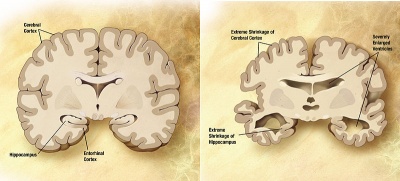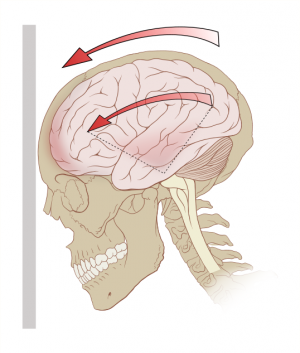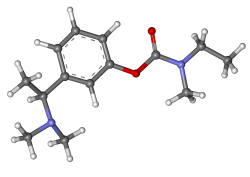Alzheimer's Disease
Original Editors - Stephanie Schwebler from Bellarmine University's Pathophysiology of Complex Patient Problems project and Irene Leahy
Top Contributors - Josie Little, Stephanie Schwebler, Laura Ritchie, Admin, Lucinda hampton, Elaine Lonnemann, Kim Jackson, Hayaa Yousri, Emily Pollom, Dave Pariser, Vidya Acharya, Kirenga Bamurange Liliane, Nikhil Benhur Abburi, Lauren Lopez, 127.0.0.1, Joseph Ayotunde Aderonmu, Evan Thomas, Shaimaa Eldib, Wendy Walker, Naomi O'Reilly, WikiSysop, Tolulope Adeniji and Safiya Naz
Definition/Description[edit | edit source]
Alzheimer's Disease (AD) is the most common cause of dementia worldwide.[1] The understanding of the pathophysiology of this condition is constantly changing. There is a complex intertwining of mechanisms that manifest as AD.
Alzheimer's Disease is characterized by cortical atrophy and loss of neurons, particularly in the parietal and temporal lobes. Also with loss of brain mass there is an enlargement of the ventricals of the brain.[2] The changes in the brain tissue slowly cause changes in the person. Often it results in Alzheimer's dementia, however some people progress differently.
Senile plaques which consist of extracellular amyloid are found in high concentrations in patients with Alzheimer's when compared with normal brains. Neurofibrillary tangles in the neo cortex, amygdala, hippocampus and basal nucleus of Meynert can also occur.[3] These plaques cause an inflammatory response that results in the damage of more neural tissue. There may be involvement of the thalamus, dorsal tegmentum, locus ceruleus, paramedian reticular area and the lateral hypothalamic nuclei.[3]
Degenerative changes in these areas are caused by:[3]
- Decreased activity of choline acetyltransferase in the cerebral cortex and hippocampus
- Loss of cholinergic neurons in the cholinergic projection pathway to the hippocampus
This link will guide you through a tour of the brain and explain further how Alzheimer's affects the brain. http://www.alz.org/brain/01.asp [4]
| [5] | [6] |
Prevalence[edit | edit source]
Approximately 4 - 4.5 million people have Alzheimer's Disease in the United States and about 8 million are affected around the world. It is expected that by 2050 that number will have increased almost three fold to around 13.2 million. The known prevalence is 6% in people over the age of 65, 20% in people over the age of 80, and more than 95% in those 95 years of age.[7] Alzheimer's disease is the fourth leading cause of death in adults, and the period from onset to death is usually 7 to 11 years.[7]
Early onset AD manifests between the ages of 30 and 60 years. This occurs in 1-6%of all cases.
Late onset AD manifests after the age of 60 years. This occurs in around 90% of cases.
Characteristics/Clinical Presentation[edit | edit source]
The progression of Alzheimer's Disease is continuous and generally does not fluctuate or improve. Often times the early symptoms can be missed or overlooked because they can be misinterpreted as signs of the natural aging process.[7] There are some key risk factors that need to be considered with Alzheimer's Disease.
The Primary Risk Factors:
- advancing age
- positive family history
- genetic markers such as apolipoprotein E4 gene
- trisomy 21
- mutations in presenilin 1 and 2
- female gender after 80 years of age
- cardiovascular risk factors such as hypertension, hyperlipidemia, obesity and hypercholsterolemia
- diabetes mellitus
The Possible Risk Factors:,
- head trauma
- history of depression
- progression of Parkinson-like signs in older adults
- lower thyroid - stimulating hormone (TSH) level within the normal range
- hyperhomocysteinemia
- folate deficiency
- hyperinsulinemia
- low educational attainment
There are also some factors that can help to defend a person against developing Alzheimer's disease. The Possible Protective Factors:
- apolipoprotein E2 gene
- regular fish consumption
- regular consumption of omega - 3 fatty acids
- high education level
- regular exercise
- nonsteroidal anti-inflammatory drug therapy
- moderate alcohol intake
- adequate intake of vitamins C,E, B6, and B12, and folate.[7]
There are also 10 warning signs that people need to be aware of to help with the early diagnosis of Alzheimer's disease.
1. Memory changes that disrupt daily life. One of the most common signs of Alzheimer’s, especially in the early stages, is forgetting recently learned information. Others include forgetting important dates or events; asking for the same information over and over; relying on memory aides (e.g., reminder notes or electronic devices) or family members for things they used to handle on their own. What's typical? Sometimes forgetting names or appointments, but remembering them later.
2. Challenges in planning or solving problems. Some people may experience changes in their ability to develop and follow a plan or work with numbers. They may have trouble following a familiar recipe or keeping track of monthly bills. They may have difficulty concentrating and take much longer to do things than they did before. What's typical? Making occasional errors when balancing a checkbook.
3. Difficulty completing familiar tasks at home, at work or at leisure. People with Alzheimer’s often find it hard to complete daily tasks. Sometimes, people may have trouble driving to a familiar location, managing a budget at work or remembering the rules of a favorite game. What’s typical? Occasionally needing help to use the settings on a microwave or to record a television show.
4. Confusion with time or place. People with Alzheimer's can lose track of dates, seasons and the passage of time. They may have trouble understanding something if it is not happening immediately. Sometimes they may forget where they are or how they got there. What's typical? Getting confused about the day of the week but figuring it out later.
5. Trouble understanding visual images and spatial relationships. For some people, having vision problems is a sign of Alzheimer's. They may have difficulty reading, judging distance and determining color or contrast. In terms of perception, they may pass a mirror and think someone else is in the room. They may not recognize their own reflection. What's typical? Vision changes related to cataracts.
6. New problems with words in speaking or writing. People with Alzheimer's may have trouble following or joining a conversation. They may stop in the middle of a conversation and have no idea how to continue or they may repeat themselves. They may struggle with vocabulary, have problems finding the right word or call things by the wrong name (e.g., calling a "watch" a "hand-clock"). What's typical? Sometimes having trouble finding the right word.
7. Misplacing things and losing the ability to retrace steps. A person with Alzheimer’s disease may put things in unusual places. They may lose things and be unable to go back over their steps to find them again. Sometimes, they may accuse others of stealing. This may occur more frequently over time. What's typical? Misplacing things from time to time, such as a pair of glasses or the remote control.
8. Decreased or poor judgment. People with Alzheimer's may experience changes in judgment or decision-making. For example, they may use poor judgment when dealing with money, giving large amounts to telemarketers. They may pay less attention to grooming or keeping themselves clean. What's typical? Making a bad decision once in a while.
9. Withdrawal from work or social activities. A person with Alzheimer's may start to remove themselves from hobbies, social activities, work projects or sports. They may have trouble keeping up with a favorite sports team or remembering how to complete a favorite hobby. They may also avoid being social because of the changes they have experienced. What's typical? Sometimes feeling weary of work, family and social obligations.
10. Changes in mood and personality. The mood and personalities of people with Alzheimer's can change. They can become confused, suspicious, depressed, fearful or anxious. They may be easily upset at home, at work, with friends or in places where they are out of their comfort zone. What's typical? Developing very specific ways of doing things and becoming irritable when a routine is disrupted.[4] This link has a describes some of the behvaiors that an Alzheimer's patient may exhibit, possible causes of the behavior, and how to respond to the behavior. http://www.alz.org/living_with_alzheimers_behaviors.asp?cons_id=4488668
| [8] |
Stages of Alzheimer's Disease[2]
Stage 1
- memory loss
- lack of spontaneity
- subtle personality changes
- disorientation to time and date
Stage 2
- impaired cognition and abstract thinking
- restlessness and agitation
- wandering, "sundown syndrome"
- inability to carry out activities of daily living
- impaired judgment
- inappropriate social behavior
- lack of insight, abstract thinking
- repetitive behavior
- voracious appetite
Stage 3
- emaciation, indifference to food
- inability to communicate
- urinary and fecal incontinence
- seizures
| [9] | [10] |
[[1]]
[[2]]
Associated Co-morbidities[edit | edit source]
Depression can often coexist with dementia because the patient may be able to recognize when they have made mistakes and it can lead to increased frustration and agitation. Along with depression patients may also have other co-morbidities such as hearing or vision impairment, congestive heart failure, symptomatic urinary tract infection, or hypothyroidism.[7]
Medications[edit | edit source]
Below is a list of some commonly used medications use in the treatments of the symptoms of Alzheimers. There is also the use of other treatments such as antioxidants, anti-inflammatory agents, and estrogen replacement therapy in women to prevent or delay the onset of the disease.[2]
Commonly Used Medications for Alzheimer's Disease[7]
Donepezil - (Aricept) has only modest benefits, but it does help slow loss of function and reduce caregiver burden. It works equally in patients with and without apoipoprotein E4. It may even have some advantage for patients with moderate to severe Alzheimer's Disease.
Rivastigmine - (Exelon) targets two enzymes (the major one, acetylcholinesterase, and butyrylcholinesterase). This agent may be particularly beneficial for patients with rapidly progressing disease. This drug has slowed or slightly improved disease status even in patients with advanced disease. (Rivastigmine may cause significantly more side effects than donepezil, including nausea, vomiting, and headache.)
Galantamine - (Reminyl) Galantamine not only protects the cholinergic system but also acts on nicotine receptors, which are also depleted in Alzheimer's Disease. It improves daily living, behavior, and mental functioning, including in patients with mild to advanced-moderate Alzheimer's Disease and those with a mix of Alzheimer's and vascular dementia. Some studies have suggested that the effects of galantamine may persist for a year or longer and even strengthen over time.
Tacrine - (Cognex) has only modest benefits and has no benefits for patients who carry the apolipoprotein E4 gene. In high dosages, it can also injure the liver. In general, newer cholinergic-protective drugs that do not pose as great a risk for the liver are now used for Alzheimer's.
Memantine - (Namenda) targeted at the N-methyl-dasparate receptor, is used for moderate to severe Alzheimer's.
Selegiline - (Eldepryl) is used for treatment of Parkinson's disease, and it appears to increase the time before advancement to the next stage of disability.
Diagnostic Tests/Lab Tests/Lab Values[edit | edit source]
There are no lab values or tests that can be used to determine the diagnosis of Alzheimer's. It is essentially a diagnosis of exclusion and the diagnosis can only be truly confirmed by a cerebral biopsy, or autopsy. The presence of dementia is needed for the diagnosis, and is established by the results of a Mini - Mental State Examination, Blessed Dementia Test, or a similar mental status test. Also there should be no disturbance in consciousness, onset between ages 40 and 90 years, most often after the age of 65, and absence of systemic or brain disorders that could account for the memory or cognitive deficits. To determine that there are no other diseases that can be causing the symptoms some tests can be done such as brain imaging, CT scan, and MRI.[2]
Causes[edit | edit source]
There is no known cause of Alzheimer's Disease. However there is some research to support that a decrease in blood pressure in older adults may be a warning sign of Alzheimer's. A diastolic pressure below 70 and declines in systolic pressure that are equal to or greater than 15mmHg over a period of 3 years can raise the risk of dementia in older adults over the age of 75.[7]
Systemic Involvement[edit | edit source]
The most noticable symptoms initially are the cognitive and memory related symptoms. However Alzheimer's disease can affect other parts of the body causing symptoms other than those affecting the memory and cognition. Often abnormal motor signs can be apparent depending on the area of the brain affected by the disease.The presence of tremors can be associated with increased risk for cognitive decline, presence of bradykinesia with increased risk for functional decline, and presence of postural-gait impairments with increased risk of institutionalization and death. Additionally, patients may develop disorders of sleeping, eating, and sexual behavior.[7]
Medical Management (current best evidence)[edit | edit source]
Since there is currently no cure for Alzheimer's Disease, medical management is focused on slowing the progression of the disease as well as treating any comorbidities the patient has and also treating any dementia related complications. Along with medical treatment there is also significant evidence to support maintaining an active lifestyle which physical therapy can help with. <span style="text-decoration: underline;" />
Physical Therapy Management (current best evidence)[edit | edit source]
| [11] |
Frequently,when a physical therapist works with a patient who has been diagnosed with an Alzheimer's, the patient may be in a structured living environment because they have progressed to a stage in the disease where their caregivers can not give the patient the proper attention that they need. Physical therapy can provide the patient with an activity that the patient can perform successfully at and it also can help to improve their breathing, mobility, and endurance. Restlessness and wandering can be typical of the patients with Alzheimer's patient and may be managed with physical therapy (by releasing some of the energy through exercises). These exercises can help to reduce the night time wanderings called sundowning. Group therapy is also successful with patients with Alzheimer's disease, but the session must not provide more stimulation than the patient is able to tolerate. Repetition and encouragement are also very important to help keep the patient's confidence high and to help with remembering the exercises. Knowing the patient is important to the therapist because it can allow for better communication, by using words and terms that the specific patient may be more familiar with. The Preferred Practice Pattern is 5E: Impaired Motor Function and Sensory Integrity Associated with Progressive Disorders of the Central Nervous System. The physical therapist can use the Global Deterioration Scale to assess the level of dementia. When a patient with Alzheimer's is placed in a comprehensive cognitive stimulation program it enhances the neuroplasticity of the patient. The exercise can also help to improve mobility, balance, and ROM for the patient as well as improve the mood.[7]
Dietary Management (current best evidence)[edit | edit source]
It has been found that maintaining a healthy diet may help to prevent or slow the progression of Alzheimer's. It is suggested that the diet be low in fat, high in omega-3 oils, and high in dark vegetables and fruits, also adding vitamin C to the diet along with coenzyme Q10, and folate may work to lower the risk of Alzheimer's.[7] There is also some interest in the use of antioxidants such as vitamin E and ginkgo, along with anti-inflammatory agents, and estrogen replacement therapy for women.[2] In addition to having a healthy diet there are a few other things that may help to reduce a person's risk for Alzheimer's disease or other forms of dementia. Staying physically and socially active can possibly help to decrease the risk for dementia along with staying mentally active. This web site has some suggestions on how to keep active socially, mentally, and physically as well as some tips on a brain healthy diet. http://www.alz.org/we_can_help_brain_health_maintain_your_brain.asp
Differential Diagnosis[edit | edit source]
- Pick's Disease
- Lewy Body Dementia
- Frontotemporal Dementia
- Dementia from multiple medications
- other potentially reversible causes of dementia
Case Reports
[edit | edit source]
Electronic tracking system and wandering in Alzheimer's disease: a case study.
Frontiers proposal. National Institute on Aging "bench to bedside: estrogen as a case study".
Resources
[edit | edit source]
- http://www.alz.org/index.asp
- http://www.nia.nih.gov/Alzheimers/Publications/adfact.htm
- http://www.physio-pedia.com/Carers_guide_to_dementia
- http://www.physio-pedia.com/Promoting_Independence_for_Persons_with_Dementia;_A_Guide_for_Carers
Recent Related Research (from Pubmed)[edit | edit source]
Failed to load RSS feed from http://www.ncbi.nlm.nih.gov/entrez/eutils/erss.cgi?rss_guid=16s3QTOAnoONPUZ951kdao4HH4cfAyXK4l4leI5DKnJP_dawZZ|charset=UTF-8|short|max=10: Error parsing XML for RSS
References[edit | edit source]
- ↑ Anand, R., Gill, K.D. and Mahdi, A.A. (2014) 'Therapeutics of Alzheimers disease: past, present and future', Neuropharmacology, 76, 27-50
- ↑ 2.0 2.1 2.2 2.3 2.4 Porth C. Pathopysiology Concepts of Altered Health States. Philadelphia PA: Lippincott and Wilkins; 2005.
- ↑ 3.0 3.1 3.2 wenk, G.L. (2003) 'Neuropathological changes in Alzheimers disease', Journal of clinical psychiatry, 64, 7-10
- ↑ 4.0 4.1 Alzheimer's Association. 2010. Available at: http://www.alz.org/index.asp . Accessed March 1, 2010.
- ↑ actionalz. What is Alzheimer's Disease?. Available from: http://www.youtube.com/watch?v=9Wv9jrk-gXc [last accessed 08/12/12]
- ↑ Erdinç Nayır. Alzheimer's Disease - 3D Health Animations. Available from: http://www.youtube.com/watch?v=y3g4emLQ1Ic [last accessed 08/12/12]
- ↑ 7.0 7.1 7.2 7.3 7.4 7.5 7.6 7.7 7.8 7.9 Goodman C, Fuller K. Pathology Implications for the Physical Therapist. St. Louis, Missouri: Saunders Elsevier; 2009.
- ↑ ALZ Answer. Seven Stages of Alzheimer's Disease. Available from: http://www.youtube.com/watch?v=QAs6r8SPRVs[last accessed 08/12/12]
- ↑ Post Gazette Now. Battling Early Onset Alzheimer's Disease. Available from: http://www.youtube.com/watch?v=Kd9p2YGlTO8 [last accessed 08/12/12]
- ↑ Alzheimer's Society. Later Stage Dementia: Bruce and Jan's Story. Available from: http://www.youtube.com/watch?v=chgshB6LCyc [last accessed 08/12/12]
- ↑ Holly Jahshan. Alzheimer's Disease: A Guide to Physical Activity. Available from: http://www.youtube.com/watch?v=K9_ER_wmN10[last accessed 08/12/12]









